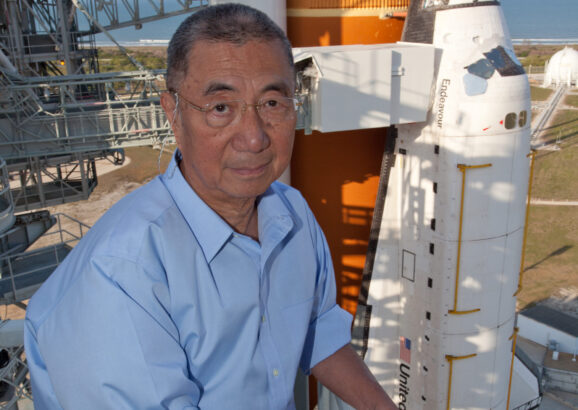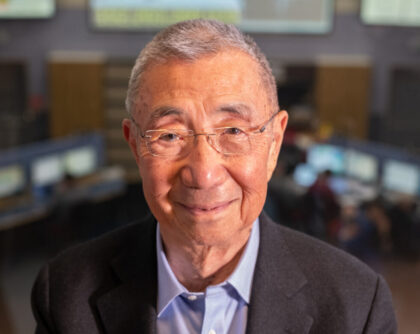Samuel C.C. Ting
1976 Nobel Laureate
Research Interests
- Discovery of nuclear anti-matter (the anti-deuteron).
- Measuring the size of the electron family (the electron, the muon, and the tau) showing that the electron family has zero size (with a radius smaller than 10e-17 cm).
- Precision study of light rays and massive light rays showing that light rays and massive light rays (vector mesons) can transform into each other at high energies and providing a critical verification of the quark model.
- Precision measurement of the radius of the atomic nuclei.
- Discovery of a new kind of matter (the J particle) at the Brookhaven National Laboratory. The Nobel Prize was awarded to Ting for this discovery.
- Discovery of the gluon (the particle responsible for transmitting the nuclear force).
- A systematic study of the properties of gluons.
- A precision measurement of muon charge asymmetry, demonstrating for the first time the validity of the Standard Electroweak Model (Weinberg, Glashow and Salam).
- Determination of the number of electron families and neutrino species in the Universe and the precision verification of the Electroweak Unification Theory.
- Proposed, constructed and leads the Alpha Magnetic Spectrometer (AMS) experiment on the International Space Station involving the participation of a 16 nation collaboration searching for the existence of antimatter, the origin of dark matter and the properties of cosmic rays.
- Development of the first large superconducting magnet for space application.
- AMS results, based on nine years in space and more than 145 billion cosmic rays, have changed our understanding of the cosmos.
Courtesy of NASA Johnson | YouTube
Biographical Sketch
Samuel Ting was born in Ann Arbor, Michigan. Shortly after, his parents, who were both graduate students at the University of Michigan, took him to China. He grew up in Chongking, Nanjing, and Taipei during the war years. He returned to the University of Michigan where he received his B.S.E. degrees (in Physics and in Mathematics) and Ph.D. (in Physics). He is the Thomas Dudley Cabot Professor of Physics at the Massachusetts Institute of Technology. Ting has always proposed and led international collaborations in experimental physics using accelerators in the U.S., Germany and Switzerland and on board the U.S. Space Shuttle Discovery and the International Space Station.
More info:
- AMS-02 Profile Page
- Autobiography for The Nobel Foundation
- The Discovery of the J Particle: a Personal Recollection (1976 Nobel Lecture)
Courtesy of MIT Infinite History Project | YouTube

A $2 billion particle detector stars in new Disney Plus docuseries ‘Among the Stars’: Q&A with principal investigator Sam Ting
As viewers will see, fixing a 7.5-ton space magnet on the ISS is no easy task.
Awards & Honors
- 2023 // Bhabha Award for "his vision and leadership of the Alpha Magnetic Spectrometer experiment on the International Space Station, which has provided data of unprecedented precision on the spectrum & composition of Galactic cosmic rays that challenge conventional models of their origin."
- 2017 // Award for Compelling Results in Physical Sciences, NASA
- 2013 // Doctor Honoris Causa, Gustavus Adolphus College, Minnesota
- 2012 // University Distinguished Professor, University of Hawaii at Manoa
- 2012 // American Association for the Advancement of Science Fellow
- 2011 // World Federation of Scientists 2009 Erice Prize for Peace
- 2005 // Doctor Honoris Causa, Hong Kong University of Science and Technology
- 2005 // Doctor Honoris Causa, National Central University, Taiwan
- 2004 // Honorary Fellow, Tata Institute of Fundamental Research, Mumbai, India
- 2004 // Doctor Honoris Causa, Rheinische Westfalische Technische Hochschule, (RWTH), Aachen, Germany
- 2003 // Foreign Member, Royal Spanish Academy of Science
- 2003 // Doctor Honoris Causa, National Chiao Tung University, Taiwan
- 2003 // Doctor Honoris Causa, Hong Kong Baptist University
- 2002 // Distinguished Science and Technology Award from the Chinese Institute of Engineers/USA
- 2002 // Doctor Honoris Causa, National Tsing Hua University (Taiwan)
- 2001 // NASA Public Service Medal
- 1996 // Member, Deutsche Academy Naturforscher Leopoldina, Germany
- 1995 // Foreign Member, Russian Academy of Sciences
- 1994 // Foreign Member, Chinese Academy of Sciences
- 1993 // Foreign Member, Hungarian Academy of Sciences
- 1993 // Doctor Honoris Causa, University of Bucharest, Romania
- 1992 // Doctor Honoris Causa, University of Science and Technology, China
- 1992 // Doctor Honoris Causa, Moscow State University, USSR
- 1990 // Doctor Honoris Causa, Columbia University, New York
- 1988 // Gold Medal for Science, Brescia, Italy
- 1988 // Golden Leopard Award for Excellence, Taormina, Italy
- 1988 // Doctor Honoris Causa, University of Bologna, Italy
- 1988 // DeGaspari Award in Science from the Government of Italy
- 1988 // Foreign Member, Soviet Academy of Sciences, USSR
- 1987 // Doctor Honoris Causa, Chinese University of Hong Kong
- 1983 // Foreign Member, Pakistan Academy of Sciences
- 1980 // Member of the Editorial Board, Mathematical Modeling
- 1978 // Sc.D. (Hon.) University of Michigan
- 1977 // Golden Plate Award of the American Academy of Achievement
- 1977 // Eringen Medal, Society of Engineering Sciences, USA
- 1977 // Thomas Dudley Cabot Professor, MIT
- 1977 // National Academy of Sciences Member
- 1976 // Member, Academia Sinica, Taiwan
- 1976 // Nobel Prize in Physics (co-recipient with Burton Richter) “for their pioneering work in the discovery of a heavy elementary particle of a new kind”
- 1975 // Ernest Orlando Lawrence Award from the U.S. Government
- 1975 // American Academy of Arts and Sciences Member
- 1970 // Associate Editor, Nuclear Physics B
Key Publications
-
M. Aguilar, et al., “Towards Understanding the Origin of Cosmic-Ray Positrons”, Phys. Rev. Lett. 122, 0411102 (2019).
-
D.P. Barber, et al., “Discovery of Three-Jet Events and a Test of Quantum Chromodynamics at PETRA”. Phys. Rev. Lett. 43, 830 (1979).
-
J. J. Aubert, et al., “Experimental Observation of a Heavy Particle J”. Phys. Rev. Lett. 33, 1404 (1974).
